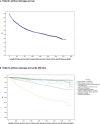Item-specific factors associated with damage accrual in systemic lupus erythematosus: insights from a multiethnic, multinational Latin American cohort
- PMID: 40738509
- PMCID: PMC12314996
- DOI: 10.1136/lupus-2025-001570
Item-specific factors associated with damage accrual in systemic lupus erythematosus: insights from a multiethnic, multinational Latin American cohort
Abstract
Objective: To identify factors associated with individual Systemic Lupus International Collaborating Clinics/American College of Rheumatology Damage Index (SDI) accrual items in 1385 patients from the Latin American SLE incident cohort (GLADEL (Grupo Latino Americano Del Estudio de Lupus)).
Methods: Longitudinal cohort study. SDI assessed yearly, and damage accrual defined as a SDI change in any individual item during follow-up. Sociodemographic and clinical characteristics at entry, along with regular medication use up to the month prior to each damage item accrued, were analysed using multivariate Cox proportional hazard models with time-varying hazard risk effect performed. Models for overall damage and 10 items with at least 28 patients per item are reported.
Results: New damage was accrued by 658 patients with SLE (48%) over a median of 54 months (p25-75: 29-71) of follow-up. Mestizo ethnicity, recent SLE Disease Activity Index (SLEDAI) and immunosuppressants were predictors of overall damage accrual, while antimalarials and rural residence were protectors; mixed effects were observed for SDI >0 and glucocorticoids (GCs) use. Protectors for scarring chronic alopecia (23.7% at 7 years follow-up) included older age, longer disease duration, diagnostic delay, SDI >0 and cytotoxic use. Proteinuria >3.5 g/24 hours (11.5% at 7 years follow-up) was associated with protective factors like older age, longer disease duration and higher GCs dose, while risk factors were Mestizo ethnicity, low medical coverage, higher SLEDAI scores and cytotoxic use. In addition, Mestizo ethnicity was a risk factor for estimated glomerular filtration rate <50% and end-stage renal disease (ESRD) whereas antimalarial protected from ESRD. GCs were risk factors for pericarditis, retinal change or optic atrophy but provided protection against proteinuria >3.5 g/24 hours. Recent disease activity and cytotoxic use were significant risk factors for additional items.
Conclusions: Factors associated with damage accrual differ substantially by individual SDI items. Mestizo ethnicity and recent disease activity increased renal risks, while antimalarials were protective. GCs showed mixed effects. Item-specific strategies are crucial to mitigate long-term damage.
Keywords: Outcome Assessment, Health Care; Risk Factors; Systemic Lupus Erythematosus.
© Author(s) (or their employer(s)) 2025. Re-use permitted under CC BY-NC. No commercial re-use. See rights and permissions. Published by BMJ Group.
Conflict of interest statement
Competing interests: Some authors reported: all support for the present manuscript (eg, funding, provision of study materials, medical writing, article processing charges): GSK (Payment was made to GLADEL). Grants or contracts from any entity: Janssen (MFU-G, BAP-E, GP-E), GSK (GP-E). PI or Co-I for 5 projects (CD). Consulting fees: Tecnofarma (MFU-G), AstraZeneca (MFU-G), GSK (MFU-G), Ferrer (MFU-G), Remegen (GP-E), Janssen (GP-E), BAGO (GP-E). Payment or honoraria for lectures, presentations, speakers bureaus, manuscript writing or educational events: GSK (MFU-G, BAP-E, CD, GP-E, ACdOeS), AstraZeneca (MFU-G, MAG, BAP-E, GP-E, ACdOeS), Janssen (BAP-E, GP-E), Novartis (BAP-E). Payment for expert testimony: GSK (MAG), AstraZeneca (MAG). Support for attending meetings and/or travel: Tecnofarma (MFU-G), Pfizer (MAG, GP-E), Rheumatology society of Paraguay (CD), Janssen (GP-E, ACdOeS), GSK (GP-E), AstraZeneca (GP-E), Abbott. Participation on a Data Safety Monitoring Board or Advisory Board: AstraZeneca (BAP-E, GP-E), Janssen (BAP-E), GSK (BAP-E, GP-E, LM). Leadership or fiduciary role in other board, society, committee or advocacy group, paid or unpaid: Cuban Society of Rheumatology (MGT).
Figures



References
Publication types
MeSH terms
Substances
LinkOut - more resources
Full Text Sources
Medical
